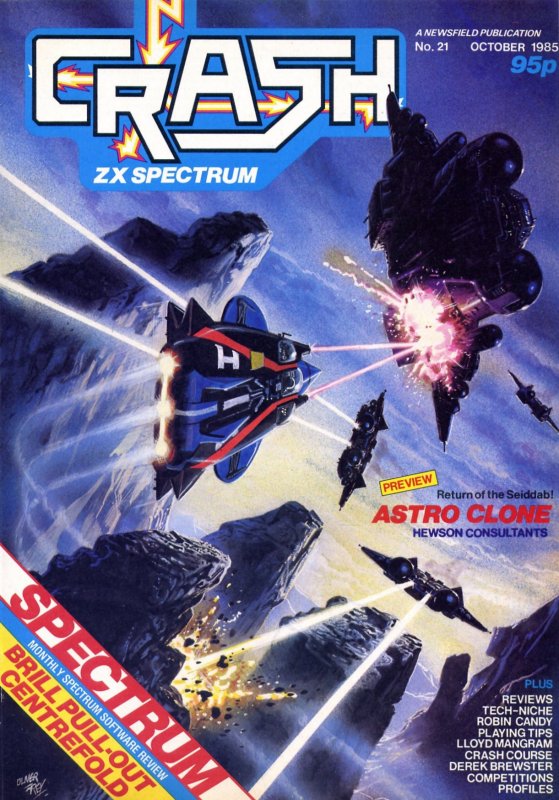

We hadn’t had a space shoot-’em-up picture on the cover of CRASH all year, and only the footballer from Issue 16 had managed to get above the stratosphere. Oliver looked around for a possible subject for this issue, settling on a game previewed in it: Hewson’s Astro Clone. In truth the cover could be referring to any number of games, or no game at all, but it’s a fascinating insight into an illustrator’s mind, showing that without some subject to hang the design on in the first place it’s hard to get going at all. The ends need a means to justify them.
The eighth PCW Show was over, giving an excuse to print lots of those pictures you cringe at years later — and people wonder why I hate being photographed! Oddly, the usual flurry of hasty releases just in time for the show failed to materialise, leaving the hordes milling around watching demos.
CRASH had little better to offer, for the real action took place in the featured previews, which gave the ever-space-grabbing Robin Candy a fine time: three previews only he could handle (according to him). A Gargoyle Games fan since Tir Na Nòg, he pestered Greg Follis daily till an early version of the next game was viewable at the company’s Dudley offices. Marsport followed in the footsteps of Dun Darach, but with a new hero and a different style of control from the familiar presentation.
A Steve Turner fan since Avalon, Robin was able to gurgle happily about Hewson’s Astro Clone, which weirdly enough resembled Marsport in some screens. And a dangerous Elite fan since Firebird released the Commodore version, he could finally get to grips with an early copy for the Spectrum.
Another preview — and it turned out to be far too early — was of Elite’s cartoon licence Scooby Doo. As outlined in this issue, the game sounded and looked marvellous, but alas it was not to be. Elite ran into programming problems which it couldn’t resolve, and dropped the game. Later it would be contracted out to Gargoyle Games to redesign and would appear in time for the next year’s PCW Show.
Actually in review, the Smashes included Nightshade from Ashby-based Ultimate with the confusing programming credit of Rare Ltd. Despite its high rating, there was a hint of disapproval in the critical comments, a note that no progress had been made since Alien 8. Speculation ran rife that perhaps the most successful software house ever had begun to lose its touch, not helped by further rumours that British Telecom, which was releasing converted Ultimate games on the 64 through Firebird, was in the market to buy the Leicestershire company.
Derek Brewster picked on an adventure with the Wild West-like title of The Touchstones Of Rhiannon to Smash — actually it was about Robin Of Sherwood — but down in arcade alley the joystick-wielders were struggling over the complex karate movements in Melbourne House’s genre-founding The Way Of The Exploding Fist. There was some disagreement over its playability, but its evident qualities made it a Smash.
The results of the 1985 CRASHtionnaire were published, revealing that at 17.2 years the average reader’s age was far higher than anyone had anticipated, and that Playing Tips was a clear winner as a section. Another result was a demand for a pay increase from Robin (it went to arbitration, but I can’t remember the outcome).
Three fresh names appeared: Simon N Goodwin’s Tech Tipster contributions started, answering those little problems that affect the technically-minded, and Ian Craig featured as On The Cover artist. Ian would later join Newsfield as an illustrator. The third was a new staff member, Sean Masterson, who took over Frontline after a two-month gap left by Angus Ryall’s departure from computer gaming.
This month saw the start of Newsfield’s Amstrad magazine AMTIX! in direct competition with Amstrad Action, which was launched at the same time. Jeremy Spencer became AMTIX! coeditor with Roger Kean, each of them doubling their existing roles. And Newsfield had spawned its first spin-off, for Amstrad Action’s publisher was Chris Anderson, ex-editor of ZZAP!.